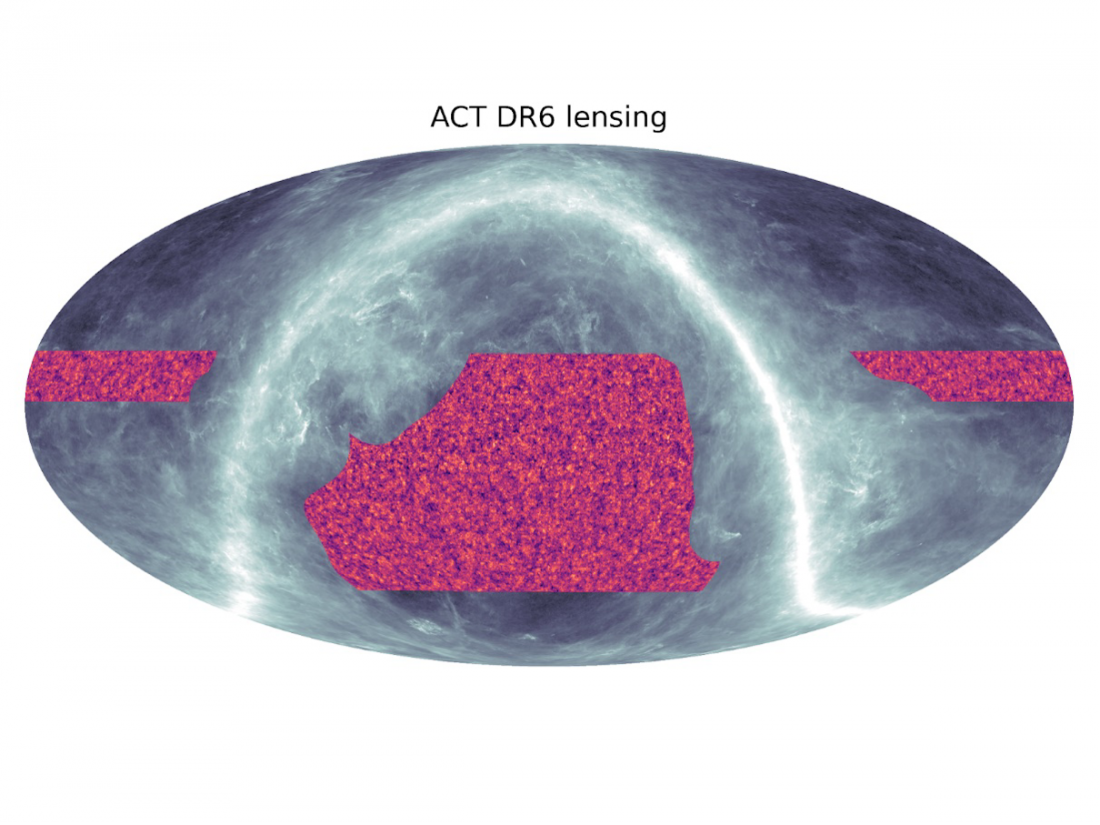A new map of the dark matter made by the Atacama Cosmology Telescope. The orange regions show where there is more mass; purple where there is less. The typical features are hundreds of millions of light years across. The grey/white shows where contaminating light from dust in our Milky Way galaxy, measured by the Planck satellite, obscures a deeper view.
Researchers from the Atacama Cosmology Telescope (ACT) collaboration, including the Kavli Institute for the Physics and Mathematics of the Universe (Kavli IPMU), have submitted a set of papers to The Astrophysical Journal, featuring a new map of dark matter distributed across a quarter of the entire sky, which confirms Einstein’s theory of how massive structures grow and bend light over the 14-billion-year life span of the universe.
For millennia, humans have been fascinated by the mysteries of the cosmos.
Unlike ancient philosophers imagining the universe’s origins, modern cosmologists use quantitative tools to gain insights into the universe’s evolution and structure. Modern cosmology’s origins were established in the early 20th century with the development of Albert Einstein’s theory of general relativity.
“We have mapped the invisible dark matter across the sky to the largest distances, and clearly see features of this invisible world that are hundreds of millions of light-years across,” said co-author and University of Cambridge Professor of Cosmology Blake Sherwin. “It looks just as our theories predict.”
Despite making up 85 per cent of the matter in the universe and influencing its evolution, dark matter has been hard to detect because it does not interact with light or other forms of electromagnetic radiation. As far as we know dark matter only interacts with gravity.
To track it down, more than 160 collaborators who built and gathered data from the National Science Foundation’s Atacama Cosmology Telescope in the high Chilean Andes observed light emanating following the dawn of the universe’s formation, the Big Bang—when the universe was only 380,000 years old. Cosmologists often refer to this diffuse light that fills our entire universe as the “baby picture of the universe,” but formally, it is known as the cosmic microwave background radiation (CMB).
The team tracked how the gravitational pull of large, heavy structures including dark matter warps the CMB on its 14-billion-year journey to us, like how a magnifying glass bends light as it passes through its lens.
“We’ve made a new mass map using distortions of light left over from the Big Bang,” said lead author of one of the papers and University of Pennsylvania Department of Physics and Astronomy Assistant Professor Mathew Madhavacheril. “Remarkably, it provides measurements that show that both the ‘lumpiness’ of the universe, and the rate at which it is growing after 14 billion years of evolution, are just what you’d expect from our standard model of cosmology based on Einstein's theory of gravity.”
Sherwin adds, “our results also provide new insights into an ongoing debate some have called ‘The Crisis in Cosmology,’” explaining that this stems from recent measurements that use a different background light, one emitted from stars in galaxies rather than the CMB. These have produced results that suggest the dark matter was not lumpy enough under the standard model of cosmology and led to concerns that the model may be broken. However, the team’s latest results from ACT were able to precisely assess that the vast lumps seen in this image are the exact right size.
“When I first saw them, our measurements were in such good agreement with the underlying theory that it took me a moment to process the results,” said University of Cambridge PhD student Frank Qu, lead author of one of the new papers. “It will be interesting to see how this possible discrepancy between different measurements will be resolved.”
To realize high-precision measurements of the lensing signals, however, the ACT team needed to mitigate contaminants from extragalactic foregrounds.
Kavli IPMU Project Assistant Professor Toshiya Namikawa is a co-author on these papers and has made major contributions to the analysis, in particular to accurately measuring a lensing map without foreground. For example, a method called bias-hardening, which he originally developed, was used to successfully mitigate these potential biases. This method will be a fundamental tool for accurately estimating lensing maps from future CMB experiments, including the Simons Observatory, in which several researchers from the Kavli IPMU are involved.
“The CMB lensing data rivals more conventional surveys of the visible light from galaxies in their ability to trace the sum of what is out there,” said ACT Director Suzanne Staggs.
“When we proposed this experiment in 2003, we had no idea the full extent of information that could be extracted from our telescope,” said University of Pennsylvania Reese Flower Professor of Astronomy and ACT Deputy Director Mark Devlin. “We owe this to the cleverness of the theorists, the many people who built new instruments to make our telescope more sensitive, and the new analysis techniques our team came up with.”
ACT, which operated for 15 years, was decommissioned in September 2022. Nevertheless, more papers presenting results from the final set of observations are expected to be submitted soon, and the Simons Observatory will conduct future observations at the same site, with a new telescope slated to begin operations in 2024. This new instrument will be capable of mapping the sky almost 10 times faster than ACT.
Read the full article by the ACT Collaboration here.




